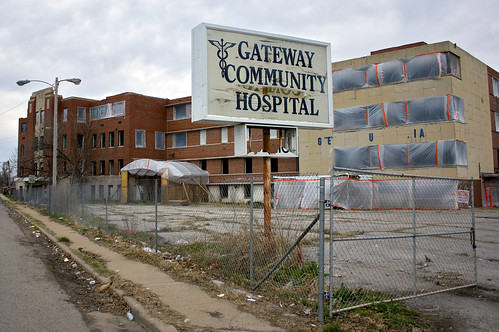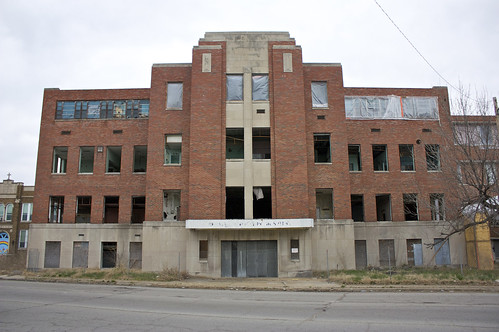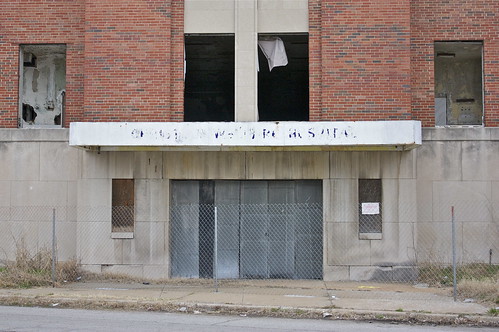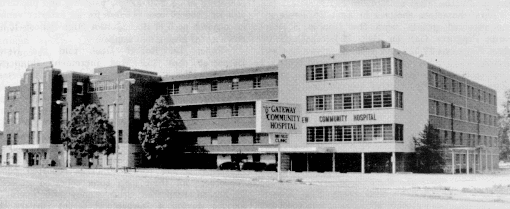An excerpt from Savage Inequalities by Johnathan Kozol on the medical facilities available to East St. Louis residents in 1990.
East St. Louis-which the local press refers to as “an inner city without an outer city”-has some of the sickest children in America. Of 66 cities in Illinois, East St. Louis ranks first in fetal death, first in premature birth, and third in infant death. Among the negative factors listed by the city’s health director are the sewage running in the streets, air that has been fouled by the local plants, the high lead levels noted in the soil, poverty, lack of education, crime, dilapidated housing, insufficient health care, unemployment. Hospital care is deficient too. There is no place to have a baby in East St. Louis. The maternity ward at the city’s Catholic hospital, a l00-year-old structure, was shut down some years ago. The only other hospital in town was forced by lack of funds to close in 1990. The closest obstetrics service open to the women here is seven miles away. The infant death rate is still rising.
As in New York City’s poorest neighborhoods, dental problems also plague the children here. Although dental problems don’t command the instant fears associated with low birth weight, fetal death or cholera, they do have the consequence of wearing down the stamina of children and defeating their ambitions. Bleeding gums, impacted teeth and rotting teeth are routine matters for the children I have interviewed in the South Bronx. Children get used to feeling constant pain. They go to sleep with it. They go to school with it. Sometimes their teachers are alarmed and try to get them to a clinic. But it’s all so slow and heavily encumbered with red tape and waiting lists and missing, lost or canceled welfare cards, that dental care is often long delayed. Children live for months with pain that grown-ups would find unendurable. The gradual attrition of accepted pain erodes their energy and aspiration. I have seen children in New York with teeth that look like brownish, broken sticks. I have also seen teen-agers who were missing half their teeth. But, to me, most shocking is to see a child with an abscess that has been inflamed for weeks and that he has simply lived with and accepts as part of the routine of life. Many teachers in the urban schools have seen this. It is almost commonplace.
There is some hope for current East St. Louis residents as the area is now served by the Kenneth Hall Regional Hospital. In a city where the median income is ~$26,000/household I doubt most residents have the luxury of having health insurance. A national health care option would have greatly improved the quality of life in the area, but the healthcare reforms passed this year fall short of offering such an option.
In December 2009 my grandmother passed away and the funeral was in St. Louis. I had some time before the service to drive through East St. Louis. Passing by the Gateway Community I noticed how easily it would have been to gain access through the ground level windows. By the time I returned in March 2010 a fence around the perimeter of the hospital had been erected. Plastic now lined the windows on the eastern wing and it appears that asbestos abatement is underway. In the parking lot was a pickup truck with a security guard keeping a close eye on us as we encircled the hospital on foot. It was a bit of a let down, as I had scheduled my day around exploring the hospital. News reports indicate that this former hospital building is indeed coming down. I was glad to get a few shots of it before it is completely gone.
Research:
Ecology of Absence – Gateway Community Hospital




This is so sad. I am a collector of electric power meters. Back in summer of 2008 I found this hospital in passing while on a meter hunt. I begged my driver to stop. I circled the hospital, located the meter box on the side in the back. I cut the old rusty seal, opened the rusty box, and to my suprise there was an old 1976 Westinghouse 3 phase meter still intact, it’s glass dome was covered in bird poop, as well as the bottom of the meter box was just filled with this big bird nest. The glass viewing window on the metal box was broken, which allowed the birds to gain access over the yrs. I assume this hospital closed it’s door in 1990, as I had my friend that works for the power co look up the meter serial number, and he told me that there has not been power at that location since 1991. The meter had to be from 1976, as that’s what the seal said, but I know the hospital is older than that, as the power co changes these meters if they go bad. The meter is like in new shape,and it cleaned up nicely, I left the origional kilowatt hours on the dial, as well, as they were put on there by the hospital. This meter was never exposed to weather, due to it being in a fully enclosed box, as opposed to a regular house meter that sticks out in the open. I went back the next week, went inside to check it out, and take some photos, and it was just a wreck. I spent about 6 hrs there, I even found an old 1970’s Ge X-Ray tube, and power supply, I took it home with me. There was all sorts of destroyed medical equipment, as well as old expired medicines from 1984 and so on I grabbed some of them and took them as well, no I will not use them, but just think it’s kind of cool. There was all sorts of stuff this was like an 80’s time capsule, just wished I would of found it after it closed. On Flickr photo sharing there are a lot of photos of this place, some of mine are on there as well. Out of everything that was destroyed, the meter remained untouched all these years, due to it being tucked outside, no one gave it a thought. I could go on and on about this place. Anyway another land mark gone, just a sign of the times. I got another meter from another place that’s gone.
You stole those items.
agreed… what happened to “take nothing but photos?”
There was all sorts of destroyed medical equipment, as well as old expired medicines from 1984 and so on I grabbed some of them and took them as well, no I will not use them, but just think it’s kind of cool. There was all sorts of stuff this was like an 80’s time capsule, just wished I would of found it after it closed. On Flickr photo sharing there are a lot of photos of this place, some of mine are on there as well. Out of everything that was destroyed, the meter remained untouched all these years, due to it being tucked outside, no one gave it a thought. I could go on and on about this place. Anyway another land mark gone, just a sign of the times. I got another meter from another place that’s gone.